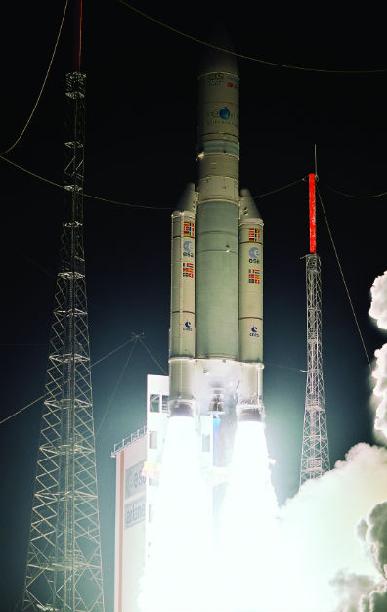Arianespace is probably best-known as the launch services operator for the European Space Agency, and thus closely associated with Ariane rocket operations from Europe's spaceport at Kourou, French Guiana. The firm, founded in 1980 and headquartered in France, has as its principle shareholders French space agency CNES and EADS Astrium, along with space companies in 10 European countries. Arianespace is also active at the Baikonur cosmodrome via Starsem, its joint subsidiary with Russia.
But it would be a mistake to think of Arianespace as just Europe's launch operator. Its record so far of 206 Ariane launches, 26 Soyuz launches (including 24 from Baikonur) and the first launch, earlier this year, of ESA's new Vega render it responsible for orbiting more than half of the commercial satellites now flying.
Indeed, Arianespace commands 64% of the Asia-Pacific satellite launch market and is optimistic it will improve that already-dominant market share.
Asia calling
Chief executive Jean-Yves Le Gall highlighted the region's importance to regional journalists on the sidelines of two telecommunications conferences he was attending recently in Singapore. "Asia is very active for satellite launches, especially for commercial satellites," he said. "We saw a move from our origins in Europe to a lot of business in the USA, and now Asia is the new frontier."
During any given year, the percentage of the firm's revenue originating in Asia can vary from one third to 50%, says Le Gall, who sees "huge potential" for launching satellites to provide telecommunications, internet and television services to the region. In 2011, the company posted revenues of €1 billion ($1.27 billion).
Le Gall's confidence stems in part from this history, and in part from the dramatic expansion of Arianespace's launcher options. Ariane 5 - capable of lifting 10t to geostationary orbit or 20t to low-Earth orbit, including payloads such as ESA's Automated Transfer Vehicle resupply ships for the International Space Station - is no longer the only show in Guiana. The introduction in October 2011 of Soyuz operations gives Arianespace a 3t capability, and Vega is expected to prove highly flexible for Earth observation and scientific payloads of up to 1.5t; a 2014 observation satellite launch contract was signed last month with the government of Kazakhstan, for what could be Vega's third flight, and Le Gall expects Asian customers to follow.
The company's most recent launch occurred on 15 May, when an Ariane 5 ECA hoisted Japan's JCSAT-13 and Vietnam's Vinasat-2 into geostationary orbit, from Kourou. The dual mission marked the 62nd launch of the Ariane 5, and its 48th success in a row.

The flight also brought Arianespace's launches for Asia-Pacific countries to 50. It has performed launches for nine countries in the region and has a backlog for four additional launches in Asia.
Overall, the company has an order book that exceeds €4.7 billion, for 22 launches of Ariane 5, 15 of Soyuz, and two of Vega.
Le Gall is dismissive of regional rivals emerging any time in the near future. He points out that only Europe, the USA, Russia, India, Japan and China have the ability to launch satellites, and of these he views Russia's Proton as Arianespace's key rival.
He believes Japan's H-IIA and B are too costly for many commercial customers. India's Geostationary Launch Vehicle is plagued by reliability issues, with five of seven attempted launches resulting in failure. China's space programme has made great strides, but international traffic in arms regulation (ITAR) restrictions preclude it from playing a major role in the commercial satellite launch business, he says.
"We'll see if regulations change in regard to China, but [even if restrictions are lifted] we will still be several years ahead of them. Arianespace sells much more than a launch vehicle. We sell a launch services package that took a long time to develop," he adds.
When asked about future innovations, Le Gall strikes a cautious tone. He notes that the Ariane 5 the company uses today is virtually identical to that used 10 years ago, and that this is unlikely to change over the next 10 years.
"It is clear that our customers prefer reliability over innovation," he says. "Innovation could bring some benefits, mainly in terms of economics, but if we fail to see many benefits from innovation it is better to stick to very conservative solutions."





